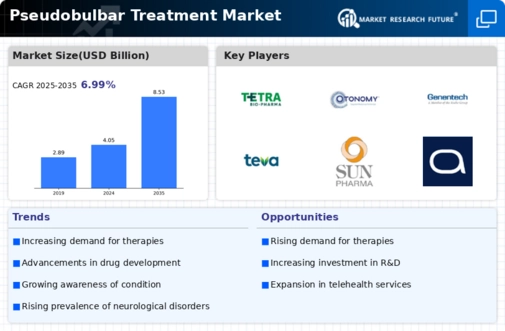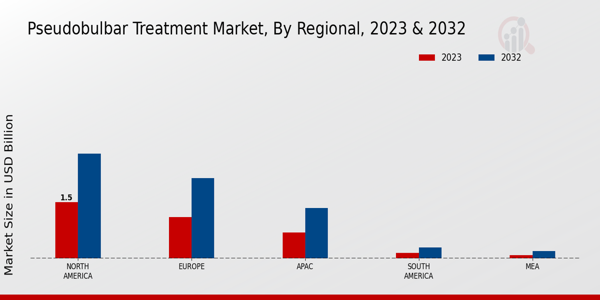Rising Awareness and Diagnosis
Increased awareness of pseudobulbar affect among healthcare professionals and patients is contributing to the growth of the Global Pseudobulbar Treatment Market Industry. Enhanced educational initiatives and diagnostic tools are leading to more accurate identification of the condition. As awareness rises, more patients are likely to seek treatment, thereby increasing market demand. This trend is expected to continue, with a compound annual growth rate of 7.0% projected from 2025 to 2035. Consequently, the market is anticipated to reach 8.53 USD Billion by 2035, reflecting the importance of early diagnosis and intervention.
Government Initiatives and Funding
Government initiatives aimed at improving mental health services are playing a crucial role in the Global Pseudobulbar Treatment Market Industry. Increased funding for research and development of treatment options, along with public health campaigns, is fostering an environment conducive to innovation. These initiatives not only support the development of new therapies but also enhance access to existing treatments. As governments recognize the impact of neurological disorders on public health, the market is likely to benefit from sustained investment, further propelling growth in the coming years.
Market Trends and Growth Projections
Charts illustrating the growth trajectory of the Global Pseudobulbar Treatment Market Industry indicate a steady increase in market value from 2024 to 2035. The market is projected to grow from 4.05 USD Billion in 2024 to 8.53 USD Billion by 2035, reflecting a compound annual growth rate of 7.0% from 2025 to 2035. These trends highlight the increasing demand for effective treatments and the potential for market expansion in response to rising prevalence and awareness of pseudobulbar affect.
Emerging Markets and Global Expansion
The Global Pseudobulbar Treatment Market Industry is witnessing expansion into emerging markets, where healthcare infrastructure is improving. Countries in Asia-Pacific and Latin America are increasingly recognizing the need for effective treatments for neurological disorders. As these regions develop their healthcare systems, the demand for pseudobulbar treatments is expected to rise. This trend is likely to contribute to the overall market growth, with projections indicating a significant increase in market value by 2035. The expansion into these markets presents opportunities for pharmaceutical companies to introduce innovative therapies.
Advancements in Pharmaceutical Research
Innovations in pharmaceutical research are significantly impacting the Global Pseudobulbar Treatment Market Industry. The development of new drugs and therapies, particularly those targeting neurotransmitter imbalances, is enhancing treatment efficacy. For instance, recent studies have shown promising results for novel compounds that may improve emotional regulation in patients. As research continues to evolve, the market is likely to expand, with projections indicating a growth to 8.53 USD Billion by 2035. This advancement not only improves patient outcomes but also encourages investment in the sector.
Increasing Prevalence of Neurological Disorders
The Global Pseudobulbar Treatment Market Industry is experiencing growth due to the rising incidence of neurological disorders such as multiple sclerosis and amyotrophic lateral sclerosis. These conditions often lead to pseudobulbar affect, characterized by uncontrollable emotional outbursts. As the global population ages, the prevalence of these disorders is expected to increase, thereby driving demand for effective treatment options. In 2024, the market is valued at approximately 4.05 USD Billion, reflecting the urgent need for therapies that can manage symptoms associated with these debilitating conditions.













